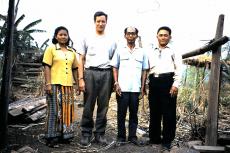The East Hampton Town Trustees have commenced a survey of docks in waterways under their jurisdiction, a plan agreed upon shortly after the nine-member body approved construction of an 80-foot dock in Three Mile Harbor in October. It was the first such approval in more than three decades.
The trustees banned applications for docks in most waterways under their jurisdiction in 1984, extending the prohibition to all but the eastern shore of Three Mile Harbor in 1987. After a contentious debate and 5-to-3 vote to approve the dock at 275 Three Mile Harbor Road in October, Francis Bock, the trustees’ clerk, insisted on formation of a committee to study and issue recommendation for a dock policy. A 12-month moratorium on construction of docks, catwalks, floating docks, floating structures, and floating platforms was enacted in November to give the trustees time to develop a policy, and also to conduct an inventory of docks in trustee waters.
Trustees were assigned water bodies in which to conduct an inventory of docks including details such as dimensions and components. In January, the trustees hired Alyson Follenius, their part-time secretary, to work on organizing, coordinating, and overseeing an analysis of structures in trustee waters during the moratorium.
At the trustees’ Aug. 8 meeting, John Aldred relayed to his colleagues his experiences conducting surveys of a few docks, suggesting how surveys might be modified based on his experience. He used an app and a form on which to input relevant information, and made drawings and took pictures of each. “It’s important for us to identify the components of the dock as they relate to the terrain under them,” he said.
In addition to site visits, “we will probably fund a drone survey of the shorelines,” Mr. Aldred said on Tuesday. That would be useful “because it will give information on the dimensions of docks, and we can use that to get an idea of the current state of what’s going on along the shoreline.”
Photographic evidence from a drone survey “will show all sorts of things — vegetation, potential upland impacts, abandoned boats,” Mr. Aldred said later. “Part of it is, we suspect there may be docks we don’t have in our records, that may be illegal. We figured that would show up in our survey, but I think that might be a little harder than we thought. . . . We don’t know what docks are legal and illegal when we’re doing the survey.” A drone survey taken in the summer, when all docks are presumably in the water, can be checked against trustee records and the survey results, he said.
The trustees’ findings would be shared with the Peconic Estuary Partnership “if they’re interested,” Mr. Aldred said.
In January, the partnership’s executive director, Joyce Novak, briefed the trustees on her group’s 2019 assessment of hardened shorelines, which surveyed docks, piers, breakwaters, groins, revetments, and jetties. She asserted at the time that there had been a 600-percent increase in the linear feet of docks in the town and an almost 300-percent increase in the linear feet of bulkheads over the last 15 years.
“When we discussed that as a board, we all were a little skeptical, especially the ones who’ve been around for a while,” Mr. Aldred said on Tuesday of the increase in linear feet of docks.
Dr. Novak acknowledged last month that the Peconic Estuary Partnership’s report “seems to have some discrepancies. So the percentage of increase is not accurate as it was presented.”
While the partnership’s overall conclusions were more than 90-percent accurate, Dr. Novak said, the statistics on docks that were presented to the trustees were preliminary and derived from a comparison of surveys conducted in 2001 by the United States Fish and Wildlife Service with data from 2016. “When doing things on a GIS,” a geographic information system, which analyzes and maps data, “you have to go in the field to ground-truth it,” she said. “In the presentation to the trustees and the town, I added the caveat that we have to ground-truth.”
The partnership’s statistics “are a more accurate reflection of the existing extent of shore hardening,” Brian Frank, the chief environmental analyst in the town’s Planning Department and a member of the partnership’s technical advisory committee, said last month. “I do think they feel more comfortable with the shore-hardening element of the data than they do the docks.”
With Reporting by
Christine Sampson




